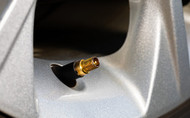Tire Valve Stems and Their Components Explained (All Types)
Posted by Agota Szabo on Sep 27th 2022
Valve stems are a crucial part of any tire. Well, they are not part of a tire per se, but they are an auto part designed to ensure the tires' safety and performance. Therefore, valves are important!
Valves keep air pressure from escaping tires. From valve cores to caps and versatile valve types, we will walk you through everything you need to know about valves and how said valves function.
What is a Valve Stem?
The small tube system that you can use to fill your tires with air is called a valve stem. This system is basically a one-way door used to transfer gas (in this case air pressure) into a chamber (tire). Different valve types are available.
What are Valve Stems for?
Valves are located on most pneumatic tires, from automobile to bicycle models. Tire valves are used to add or remove air pressure inside the tire. Once air pressure enters the tire, tire valves do not let it escape on their own.
A tire stem helps tires keep their optimal pressure levels, by using its different components. Valves consist of a valve stem body, a valve core, and a valve stem cap. These work together to keep the correct pressure levels inside the tires.
The various components of valves work together to enable the tire's secure performance. Air pressure loss can occur if the valves are damaged. But, as long as they properly function, valves will hold air and guarantee the tires' performance.
Different Types of Valve Stems
There are versatile types of tire valves available for purchase. The type you need greatly depends on various components: mainly what type of tire the valves are used on.
There are three different tire air valve stems manufactured:
- Tubeless Rubber Snap-in Tire Valve
- Tubeless Snap-in High-Pressure Tire Valve
- High-Pressure Metal Clamp-in Tire Valve
These have various applications! Let's talk about them in more detail.
Tubeless Rubber Snap-in Tire Valve
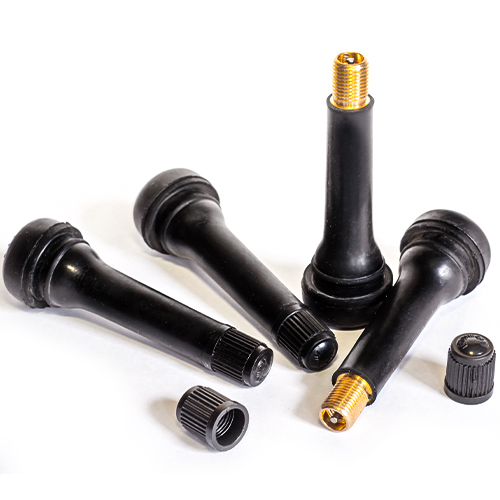
Probably the most common valve type is the tubeless rubber snap-in tire valve, as they are suitable for passenger cars, light-duty trailers, and various light trucks. Additionally, they can be used in autocross competitions as well.
These tire valves hold a maximum of 65 psi, as a cold tire inflation pressure. This valve stem size usually ranges between 0.7" to 2.5" and it can fit 0.453" or 0.625" diameter rim holes. Often they sport plastic valve stem covers, but some can be purchased with chrome sleeves or a metal tire pressure cap. However, this is merely for aesthetic purposes.
Check out this valve stem sizes chart:

Tubeless Snap-in High-Pressure Tire Valve
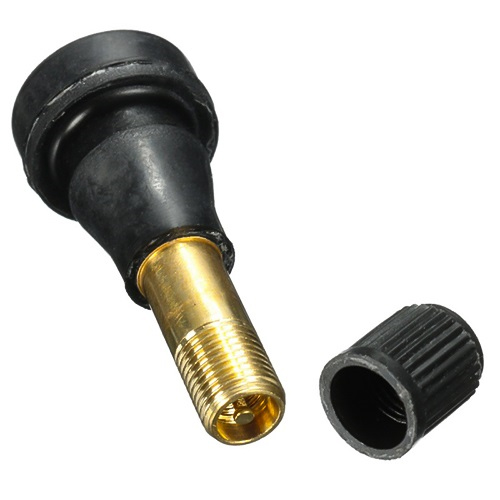
The tubeless snap-in high-pressure tire valves function in the same manner as the previous type does. However, they are used for applications where the maximum pressure is above 65 psi. In other words, they are for medium- to heavy-duty trucks and trailers, that use pressure to handle larger weights.
These tire valves are made in two rim hole fittings: 0.453" for tires with a max cold inflation pressure of 80 psi, and 0.625" for those with 100 psi. Due to the vehicle applications, these valve stem sizes range between 1.25" to 2". High-pressure valve stems are designed for steel wheels. They are equipped with thick rubber snap-in bases, metal barrels, and plastic pressure caps.
Size chart of high-pressure, tubeless snap-in valves:

High-Pressure Metal Clamp-in Tire Valve
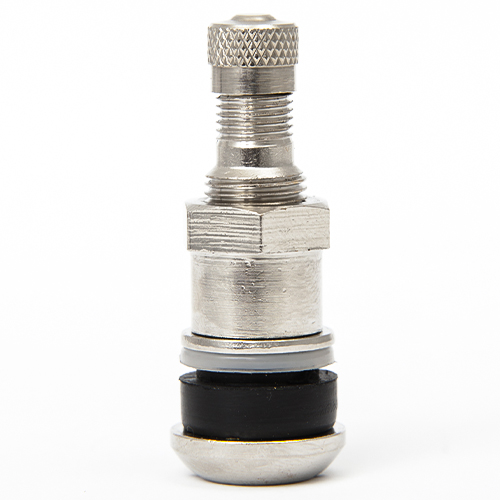
High-pressure metal valve stems are clamp-in models that use a rubber grommet, which seals the valve against the wheel when you tighten the holding nut. These valves are generally manufactured for high speed, racing vehicles, or for vehicles exceeding 130 mph.
Most metal clamp-in tire valves are available for 0.453" and 0.625" rim holes. However, some special applications are available for 0.236" and 0.315" rim holes. Additionally, they come in straight or bent styles to accommodate even unique wheel shapes. These valves hold maximum cold tire inflation of 200 psi.
These valves have two fitting types: with the retaining (holding) nut inside or outside of the rim. For aesthetic reasons, many drivers prefer it to be hidden inside the rim. However, outer placements allow you to tighten the nut whenever it is necessary.
Valve Stem Components
We have talked about the types of tire valves you can purchase for different vehicles. Now, let's see their components.
Like most auto parts, valves also consist of multiple parts, which are:
- Valve cap
- A valve core
- Valve extension
These individual parts of valves work together to hold air in the tires. Some are crucial and some don't have to be used. However, these parts working together will guarantee the vehicle's secure drive.
Valve Stem Caps
A valve cap should be used on all valve stems. There is a good reason for this! Moisture contamination and loss of air pressure at high speeds can cause problems. They can damage the valve core or cause the tire to do flat. However, a valve cap will help prevent these issues.
Tire valve caps are available to be manufactured from plastic, metal, or metal with a special screwdriver design. When these caps are used greatly depends on which vehicle they are on. When it comes to everyday driving, a plastic tire pressure valve cap should be enough. However, for racecar applications, a metal one is better. Tire stem caps are either knurled or hexagon-shaped to make them easier to remove.
While missing tire valve covers are not the end of the world, it is advisable to replace them. For one, it is a second seal that prevents pressure from escaping, in case valve core damage occurs. On the other hand, it also makes sure that sand, dirt, and moisture does not enter the stem and damage it.
Valve Core Types
A valve core is the main seal inside the stem. This part of the stem seals tire pressure inside the tire, preventing it from escaping. It should be tightly screwed into the valve core chamber. They are manufactured with shorter (for high speed applications) and longer lengths, and nickel-plated and brass valve cores are available.
It is important that you only use a nickel-plated valve core with an aluminum tire pressure sensor valve stem. This is due to brass valve cores in such applications experiencing corrosion that can transfer and affect the aluminum wheel as well. This is to protect the wheel and its integrity.
These valve cores basically consist of a spring-loaded pin that is moveable. This allows air pressure to inflate and deflate the tires. This valve stem seal prevents pressurized air from escaping the tires when the caps are off. The valve stem core is durable, but dirt, moisture, and sand can damage it. Dirt and sand will prevent valve cores from sealing properly, while moisture will freeze and damage the valve cores.
Valve Extensions
If you fit wheel covers on your car, you can use valve extensions to make the inflation process easier. These nylon or metal extenders are available in sizes between 0.5" and 2".
It is important to select the ideal extension length or to purchase durable, preferably metal, ones. Road and weather conditions and driving habits can easily damage these extensions, which will leave to other issues.
TPMS Valve Stem Types
If your vehicle uses direct TPMS sensors, then the valve stems also hold the sensor inside the tire. Mechanics do this with metal clamp-in or rubber snap-in valves. These TPMS sensor tire valve stems work together to transmit information to the TPMS monitor.
The two different TPMS stem types function a bit differently. Let's see how!
Clamp-in Valve Stem for TPMS
A clamp-in valve stem-sensor combination fits the sensor with a rubber seal and a retaining. These two parts, along with the valve cores and caps, need to be tightened correctly, in order to prevent pressure loss.
These TPMS rubber valves need nickel-plated valve cores to prevent damage. Galvanic corrosion can damage brass cores, which will transfer onto the aluminum barrel with time - leading to even bigger damage.
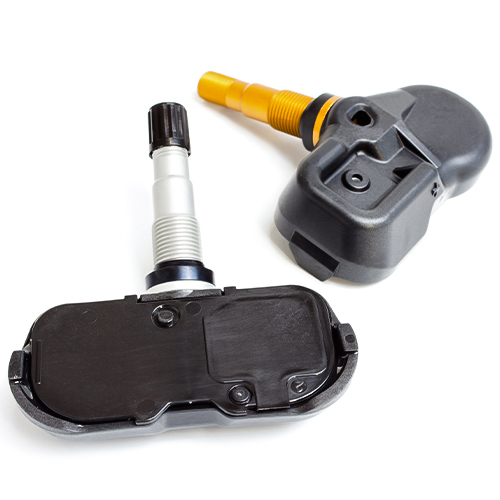
Rubber Snap-in Valve Stem for TPMS
The other type of TPMS sensor tubeless tire valve is the rubber snap-in version. These accept TPMS sensors can be different, and purchasing valve stems that accommodate them in crucial.
If the TPMS stems are not compatible, it will lead to air pressure loss. Using the correct combination of valves and TPMS sensors will ensure a safer driving experience.
Tire Valve Stems for Nitrogen Tires
Have you ever noticed a vehicle with green valve stem caps?
Well, there is a reason for their distinct color! These valve stem seals keep the pressure inside of nitrogen-filled tires. Many believe that adding nitrogen in tires improves their performance, durability, fuel economy, etc.
Therefore, nitrogen valve stem caps are green!
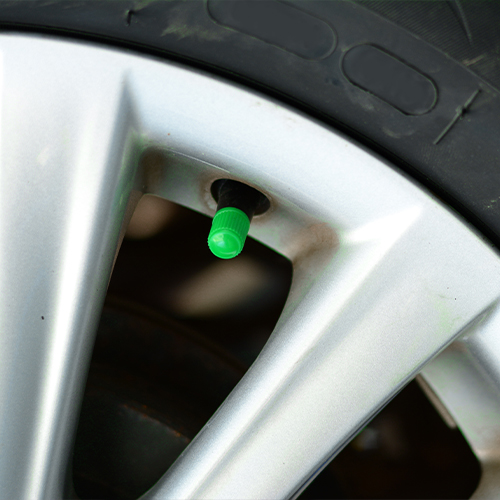
FAQs
Are Valve Stems Replaced with New Tires?
Usually, when mounting new tires on a vehicle, it is advisable to get new valve stems for tires as well. However, when you purchase new tires, the tire valve stem is not included.
What Size Valve Stem do I Need?
The valve stem sizes you need depend on the rim size. Low-profile rims (up to 0.9") will need a 1.5" stem while a 1.3-1.7" rim should have a 2.3" valve stem. Anything taller than 1.9" needs at least a 3.1" valve stem to properly function.
How to Find a Leak in a Tire?
To find a slow leak in a tire, you will needs a spray bottle and soapy water. Mix liquid soap and water in a spray bottle and spray the entire tire (sidewalls, tread area, along the rim, and the valve stem). The slow leak will be there the soapy water forms small bubbles with the escaping air.
Why does Air Escape from a Tire When the Tire Valve is Opened?
Air pressure escapes the tire when the valves are open because of the different pressure levels inside the tire and in the atmosphere. The high pressure of the tire flows out until the tire features the atmospheric pressure. This causes the tire to go flat.













